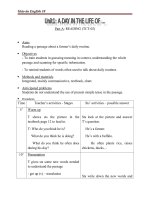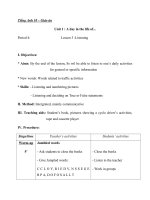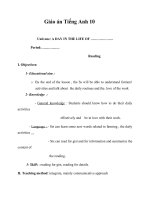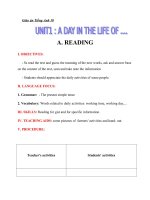Giáo án Tiếng Anh 10 Unit 1: A day in the life of…
Bạn đang xem bản rút gọn của tài liệu. Xem và tải ngay bản đầy đủ của tài liệu tại đây (168.51 KB, 33 trang )
Giáo án Tiếng Anh 10
UNIT 1: A DAY IN THE LIFE OF......
LESSON 1: READING
Date of
Students absence
Notes
teaching
Class
10…
10…
10…
I- Objectives:
- Students read and guess the meaning of words in contexts.
- They read and answer questions about the texts.
- They practise scanning specific information in the texts
II – Language focus :
1.Vocabulary: - Words concerning daily activities of people.
2.Grammar:
- The present simple tense
- The past simple tense.
- Adverb of frequency.
III- Skill:
-Reading: read a passage about a day in the life of a farmer.
IV. Teaching aids: - picture, board, chalks, textbook, handouts
V. Procedures:
Time
Teacher's activities
Students' activities
1. Warm- up:
5’
+ Aims: to introduce the topic of the
lesson and to raise sts' interest.
- Ask sts to close their books
- Deliver handouts, and ask sts to match a
noun in column A with a phrase in column
- close their books
- match two columns
B.
A
B
1. a teacher
a. does homework
2. a doctor
b. works in the field
3. a student
c. delivers letters
4. a postman
d. looks after patients
5. a farmer
e. gives lessons
- Ask ss to match quickly in one minute,
then ask some ss to stand up to answer T's
questions.
T : What does a teacher do?
S1 : He gives lessons
T : What does a doctor do?
S2 : He looks after patients.
.........
- After the last question, T introduces the
new lesson.
T : What does a farmer do?
S5 : He works in the field.
2. Before you read:
- Aims: to revise the present simple and to
provide sts with some new words.
10’
- Ask sts to open their books and look at
"Before you read" , explain what they are
going to do.
- Do the first example.
T: What time do you often get up?
- Ask sts to work in pairs to ask and
answer about their daily routine, using the
cues in the textbook.
- Ask them to work in 3 minutes,
meanwhile T moves round to help if
S: I often get up at six
S1: What time do you often go to
school?
necessary.
S2: I often go to school at 6.30
- Ask some pairs to report .
S3: What time do you often have
- Ask sts to look at the picture in the
textbook and guess the man's job.
- Introduce the topic of the reading
breakfast?
S4: I often have breakfast at 6.15.
passage: " A day in the life of a farmer"
............
S11: What do you often do in the
- Introduce some new words:
- plough (v) ( the action of the man in the
evening?
S12: I often do my homework.
picture)
- 'harrow (v) : bừa
S: I think he is a farmer.
- a plot of land (n) ( point at the picture)
- 'peasant (n) : a poor farmer
- pump(v) : bơm
- trans'plant (v)( use 2 words"plant" and
"trans-" to explain).
do the transplanting
- Ask sts to listen and repeat these words
twice, then ask some sts to read again.
3. While you read:
- Aims: Sts practise reading
+ Task 1:
- Ask sts to read the passage about a
farmer, Mr. Vy and his wife, Mrs. Tuyet.
and do Task1.
20’
- Listen and repeat.
- plough
- peasant
- harrow
- pump
- a plot of land
- transplant
- Ask sts to work individually in 5 minutes
to do this task.
- Guide sts to read through the passage ,
then focus on only the sentences
surrounding the italicised words to do the
task effectively.
- Ask them to share their ideas with their
parners.
- Ask 4 sts to stand up to answer , then
give remarks.
- Translate number 4 into Vietnamese in
case sts do not know the word " contented
with" and three options.
+ Task 2:
- Ask sts to read the passage again and
answer the questions about Mr. Vy and
Mrs. Tuyet.
1. C
2. C
3. A
4. A
- Ask them to work in pairs , one asks and
one answers.
- Move round to make sure that all sts are
working and to help them if necessary.
- Ask some sts to report and give
S1: What is Mr. Vy's occupation?
feedback .
S2: He is a farmer.
S3: What time does he get up and
+ Task 3:
- Ask sts to read the passage again , and
explain what they are going to do.
- Ask them to complete the note in 7
minutes, then discuss their answers with
their partners .
- Ask three sts to report their answers
aloud.
- Check and give remarks.
what does he do after that?
S4: He gets up at 4.30, then he
goes down to the kitchen to boil
some water for his morning tea.
S5: What does he do in the
morning?
S6: In the morning he ploughs
and harrows his plot of land,
drinks tea and smokes local
tobacco during his break.
S7: What do Mr. Vy and his wife
do in the afternoon?
- Work in groups to discuss.
S8: They repair the banks of their
plot of land. Mr. Vy pumps water
- Ask one member of their groups to report
if possible.
4. After you read:
- Aims: to help sts to consolidate what
they have read.
- Ask sts to close their books.
- Ask them to work in small groups of
into it while his wife does the
transplanting.
S9: Are they happy with their
lives or not? Why?
S10: Yes, they are. Because they
love working and they love their
children.
three or four to talk about Mr. Vy and
Mrs. Tuyet's daily routines basing on their
note in Task 3.
- Encourage them to use their own words.
- Ask one or two pairs to report.
- In the morning:
+ 4.30: The alrm goes off and
Mr. Vy gets up, goes down to the
kitchen, boil water for tea, has a
quick breakfast, leads the buffalo
9’
to the field.
+ 5.15: he leaves the house
+ 5.30: he arrives in the field,
ploughs and harrows his plot of
land.
+7.45: He takes a rest
+ 10.30: he gose home
+ 11.30: he has lunch with his
family.
- In the afternoon:
+ 2.30: they go to the field again,
repair the bank of the plot of land.
He pumps water into it, she does
the transplanting.
1’
+ 6.00: they finish work.
+ 7.00: they have dinner.
- After dinner:
+ They watch TV, sometimes
5. Homework:
- Ask sts to write full passage about Mr.
Vy and Mrs. Tuyet basing on what they
have discussed in Post- Reading.
VI-EXPERIENCES:
they see their neighbours for a
cup of tea and chat with them.
+10.00: they go to bed.
UNIT 1: A DAY IN THE LIFE OF......
LESSON 2: SPEAKING
I. Objectives:
- Students work in pairs to ask and answer about one's daily activities using a
timetable or pictures
- They can talk about their daily routines.
II-Language focus :
1.Vocabulary: - Words concerning daily activities of people.
2.Grammar:
- The present simple tense
- The past simple tense.
- Adverb of frequency.
III- Skill:
-Speaking: Speak about time table of a student.
IV. Teaching aids: - picture, board, chalks, textbook, handouts
V. Procedures:
Time
Teacher's activities
Students' activities
1. Warm-up:
5’
- Aims: to revise the names of school
subjects .
- Ask sts to close their books.
- Close their books.
- Work in groups of three or four
to match as quickly as possible.
- Deliver the first handout.
A
B
1. Civic education
a. Toán học
- Speak aloud their answers:
2. Technology
b. Vật lý
1-f ; 2-i ; 3 - a; 4 - g; 5 - b; 6 - j;
3. Maths
c. Tin học
7 - k; 8 - d; 9 - e; 10 - h; 11 - c.
4. Literature
d. Thể dục
5. Physics
e. Địa lý
6. Biology
f. Giáo dục CD
7. Chemistry
g. Văn học
8. Physical education
h. Lịch sử
9. Geography
i. Công nghệ
10. History
j. Sinh học
11. Informatics
k. Hoá học
- Ask them to match one item in column
A with one item in column B.
- Ask them to work in groups in 2
minutes, then check this exercise in
chorus.
- Ask sts to read aloud the names of
these subjects in chorus.
2. Pre-Speaking
- Aims: to introduce the verb tense and
9’
the way to tell clock time.
- Introduce briefly what sts are going to
do in this lesson.
- Ask sts about the verb tense to use in
- The present simple tense.
talking about daily routines.
- Remind sts of some rules of the present
simple tense.
- Recall the way of telling time.
T: ( write on the board) 7.30 ans ask a st
S: seven thirty or half past seven.
to read it aloud.
- Write some more examples and ask sts
to read aloud.
- Ask sts about the question :
- Ask sts to make question for the
following sentence:
S: The question begins with "
What time..........?"
" Mai goes to school at 6.30 a.m"
- Ask sts to give more examples.
S: What time does Mai go to
school?
3. While- Speaking
- Aims: Sts practise speaking in pairs
+ Task 1:
- Ask sts to open their books.
- Introduce the requirement of the task.
20’
- Ask sts to look at the timetable in the
textbook and read through it.
- Do the first example with a student.
T: What time does Quan have a Civic
- Open the textbook.
- Listen to the teacher.
- Look at the timetable and try to
understand it.
Education lesson on Monday?
T: What lesson does Quan have at 7.15
a.m on Monday?
- Ask the whole class to read these
sentences again.
S: He has a Civic Education
lesson at 7.15a.m
S: At 7.15 on Monday he has a
Civic Education lesson.
- ask two pairs to read again.
- Ask sts to work in pairs in 10 minutes
to ask and answer about Quan basing on
the timetable.
- Move round to hepl sts and to correct
any mistakes if there are.
S1: What time does Quan have a
Literature lesson on Tuesday?
S2: He has a literature lesson at
8.05 a.m
S3: What lesson dose Quan have
at 10.40 a.m on Thursday?
- Ask five pairs to report because of the
time limit.
S4: he has a Chemistry lesson.
S5: What time does Quan have a
Physics lesson on Wednesday?
- Listen and give remarks.
+ Task 2:
- " Quan is at school in the morning, and
what does he do in the afternoon? Please
S6: He has a Physics lesson at
9.55 a.m
S7: What lesson does Quan have
at 8.55 on Friday?
look at pictures in task 2"
S8: He has an English lesson.
- Ask sts to work in pairs to ask and
S9: What time does Quan have a
answer about Quan's activities.
Class Meeting on Sarturday?
- do the first example:
S10: He has a class meeting at
T: ( look at picture 1) What does Quan
10.40 a.m.
do at 2.00 p.m?
- Ask sts to work in the same way,
- look at pitures in task 2 and
remind sts to use the present simple tense think of the phrases to talk about
with the third person.
- Move round to control the activity and
Quan's activities.(eg: do his
homework, get up,etc)
to help sts if necessary.
- After sts have discussed, T can aks a
student to talk about all Quan's activities
in the afternoon.
4. Post -Speaking:
- Aims: sts practise speaking freely, they
can express their own ideas.
S: He gets up at 2.00 p.m
+ Task 3:
- Ask sts to think about themselves, and
then work in small groups to tell their
friends about their daily routines. Remind sts that they are using the
present simple with the first person.
10’
" At 2.00 p.m Quan gets up, he
starts to study at 2.15 p.m. he
studies until 4.30 and then he
watches T.V. At 5.00 he rides to
- Move round to check the activities and
the football yard. At 5.15 he
to make sure that sts are working
begins playing football. He goes
effectively.
home at about 6.30 p.m......."
- Ask one or two sts to report in front of
1’
the whole class.
- Think about theit daily activities
- check and give remarks.
and talk to their friends.
5. Homework:
- Try to use English to talk.
- Write a paragraph ( about 80 words)
about their daily routines in their
workbook.
VI-EXPERIENCES:
UNIT 1: A DAY IN THE LIFE OF......
Period : 4
LESSON 3: LISTENING
Date of
Class
Students absence
Notes
teaching
10…
10…
10…
I. Objectives:
Students know how hard manual labourer in Vietnam work and appreciate them.
II-Languge focus:
1.Vocabulary: - Words concerning daily activities of people.
2.Grammar:
- The present simple tense.
- The past simple tense.
- Adverb of frequency.
III- Skills: + Listening comprehension.
- Students listen and number the pictures in their correct order.
- Students listen and decide whether the staments are true or false.
IV- Teaching aids: - Tape, board, chalk, textbook.
V-- Procedures:
Time
5’
Teacher’s activities
Students’ activities
1. Homework checking:( 5 mins)
Two sts tell the whole class about their
daily routines
2. Before you listen:
Aims: focus sts on the topic and review/
introduce the words and phrases used to
10’
describe a cyclo driver’s daily activities.
a. T asks sts to work in groups and make a
list of vehicles and the people who operate - work in groups and recall the
them, then compare their list with other vehicles and their operators then
groups’
make a list on a sheet of paper
- compare theirs notes.
- Introduce the topic of the listening text: - listen to the T and open their
‘A day in the life of a cyclo driver’ and books
asks sts to open their books.
- Ask sts to work in pairs to ask and
answer the questions in the textbook
Have you ever traveled by cyclo?
When was it?
Is it interesting to travel by cyclo?
- Work in pairs to ask and answer.
- Some pairs stand up and report.
S1:
Have you ever traveled by
cyclo?
Which do you prefer, going by
bicycle or by cyclo? Give reasons.
S2: Yes, I have.
- Move around to help sts then ask some S3: When was it?
pairs to report.
- Give remarks.
S4: Last summer holiday...
S5: Is it interesting to travel by
cycle?
S6: Yes, it is.
S7: Which do you prefer, going by
bicycle or by cyclo?
S8: I prefer traveling by cyclo
because I have time to look around
and I’m not tired.
b. T asks S to look at the words in the
book and read after T .
- Introduce some new words
- 'passenger (n): (in the pictures)
- look at the words and read after T
.
- 'district (n): e.g.: Ba Dinh district, - copy the words and phrases.
Thanh Mien district
- drop (v): when the passenger gets off
the cyclo.
- 'pedal (v) = cycle (v)
- 'purchases (n) = the shopping: The
things someone has bought
- food stall (n) : (In the picture)
- Read the words aloud and asks sts to
repeat.
- Ask some sts to read the words again.
3. While you listen:
+ Task 1:
- listen and repeat.
- Some individuals read the words
aloud
Aims: Practise listening and ordering
pictures.
- Ask sts to work in pairs, look at the
pictures in the textbook and describe each
20’
picture.
- Do the first example:
In the first picture, a cyclo driver is - look at the pictures and listen to
cycling his cyclo and taking a woman to the T.
somewhere.
- describe the other pictures in
- Introduce the situation about Mr. Lam, a pairs.
cyclo driver in Hochiminh city talking
about his daily routines. T asks sts to listen
to the tape/ teacher and number the
pictures in the correct order.
- listen to the teacher.
- play the tape/ read the text twice.
- Ask sts to share their answers in pairs.
- Get sts’ answers.
- play the tape once again, stop where
necessary and conduct the correction.
- listen to the tape / the teacher and
do the task
- Share their answers.
- give feedback.
- check their answers , and then
+ Task 2:
Aims: Practice listening for specific
information by deciding if the given
correct their work if they have any
wrong answers.
Key: 5 – 6 – 1 – 3 – 2 – 4
statements are true or false.
- ask sts to have a look at the statements
and read them in pairs and make sure they
understand the statements.
-Ask sts to listen to the tape/T again and
tick the box to indicate if the statements - Read the statements , underline
the key words in each sentence.
are true or false.
- Ask sts to compare their answer in pairs.
8’
- Checks sts’ answers.
- Play the tape once again, stop where
necessary and conduct the correction.
- Try to guess whether each
sentence is true or false.
- Listen and do the task.
- Share their answers with their
partners.
4. After you listen:
- Give answers.
- Ask sts to work in pairs and use the
suggested words to ask and answer about
the cyclo driver.
- Move round to check the activities and to
- Listen again and check.
Key: 1F; 2T; 3F; 4F; 5F.
make sure that sts are working effectively.
- Ask one or two sts to retell the cyclo
2’
driver’s routines in front of the whole
- Work in pairs to ask and answer
class.
questions such as:
- Check and give remarks.
" What is the man's name?"
5. Homework:
" What does he do?"
- Write a short paragraph about Mr. Lam's
routines
VI-EXPERIENCES:
.............
UNIT 1: A DAY IN THE LIFE OF......
Period : 5
LESSON 4: WRITING
Date of
Class
Students absence
Notes
teaching
10…
10…
10…
I. Objectives:
-By the end of the lesson, students will be able to write a narrative.
II-Languge focus:
1.Vocabulary: - Words concerning daily activities of people.
2.Grammar:
- The present simple tense.
- The past simple tense.
- Adverb of frequency.
III. Skills: + Reading: Students read a passage to find the verbs in the past simple
and the connectors.
+ Writing a narrative using the prompts.
+ Speaking: - Students discuss in groups to share their answers.
IV. Teaching aids: - A picture, board, chalk, textbook.
V. Procedures:
Time
Teacher's activities
Students' activities
1. Warm- up:
5’
Aims: To raise students' interest.
- Look at the picture.
-Show a picture that teacher prepared
in advance about the explosion in
Twin Towers in 2001.
- Ask some questions:
T: What is happening ?
T: Do you know where it happened?
T: When did it happen?
T: How did it happen?
S: The buildings are on fire.
S: It happened in the U.S.A
S: It happened on September
11th , 2001
S: Two planes carrying bombs
- Tell sts that they are going to write a
crashed into two buildings and
narrative of past events.
killed a lot of people.
2. Before you write:
20’
- Aims: to provide sts with the
materials ( vocabulary, grammar,
form) to write.
+ Task 1:
- Look at Task 1.
- Read through the passage
- Ask sts to look at Task 1 .
individually .
- Ask them to read through the passage
- S: The most frightening
in two minutes to get the main idea.
experience of the writer's life
- Ask one student to report.
when he(she) travelled on a
plane on 14th July 1995.
- Explain some new words/ phrases in
the passage:
+ stare death in the face ( explain the
meaning of each word ,then let sts
guess the meaning of the whole phrase)
+ 'fasten(v)( demonstrate)
- Listen and repeat:
+ stare death in the face
+ fasten
+ dip
+ dip (v) : move to a lower level.
- Ask sts to listen and read these words
again.
- Ask them to read the passage again
more carefully and do task 1 in 5
minutes.
- Move round to make sure that all sts
- Read the passage again and do
are working.
task 1.
- Ask them to share their answers with
+ Verbs used in the past simple:
their partners.
stared, was, arrived, got, took off,
- Check the task by asking two sts to
began,thought, were told,
report.
seemed, realised, were,
- Give remarks.
screamed, thought, had, felt,
gained, announced, landed.
+ Task 2:
- Ask sts to read the passage again and
in groups to do task 2.
+ Connectors( expressions of
time): on that day, at first, then, a
few minutes later.
- Divide the class into three regions:
one identifies the events, one identifies
the climax and the rest identifies the
conclusion.
- work in groups.
- Ask sts to work in only 2 minutes.
- Ask three representatives of three
groups to report.
+ The events: people got on
plane, plane took off, hostesses
- Draw the conclusion about writing a
were just beginning to serve
narrative.
lunch when plane began to shake,
+ Form: 3 parts: - introduction.
- body: events, climax
- conclusion
10’
- Report the answers:
plane seemed to dip, people
screamed in panic.
+ The climax: We thought we had
only minutes to live.
+ Verb tense: the past simple tense.
+ The conclusion: the pilot that
+ Connectors: at that time, on that
everything was all right, we
day,then, after that, a few minutes
landed safely, it was the most
later, until, etc.
frightening experience of my life.
- Ask sts to do task 3 but before that
explain some new words:
- Listen and repeat these words.
+ 'discotheque (n) : disco
+ choke (v): to be unable to breath
- Ask sts to listen and read these words
again.
3. While you write:
- Aims: students practise cotrolledwriting.
9’
+ Task 3:
- Write the passage into their
notebooks.
- Ask sts to build up a narrative about a
hotel fire using the prompts.
- Ask them to work individually.
Last year I spent my summer
holidays at a seaside town. The
- Move round to conduct the activity
hotel was modern and
and to note down sts' mistakes.
comfortable. I had a wonderful
- Ask sts to share their answers with
their partners.
4. After you write:
-Aims: to get feedback.
holiday until the fire.
It was Saturday evening and
everyone was sitting in the
discotheque on the ground floor.
It was crowded with people. They
- Ask sts to report their work sentence
were dancing and singing
by sentence.
happily. Suddenly we smelt
- Remind sts that they should use the
smoke. Then black smoke began









